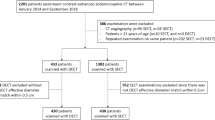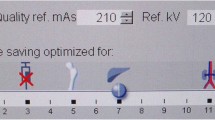Abstract
In the present study, radiation doses and cancer risks resulting from abdominopelvic radiotherapy planning computed tomography (RP-CT) and abdominopelvic diagnostic CT (DG-CT) examinations are compared. Two groups of patients who underwent abdominopelvic CT scans with RP-CT (n = 50) and DG-CT (n = 50) voluntarily participated in this study. The two groups of patients had approximately similar demographic features including mass, height, body mass index, sex, and age. Radiation dose parameters included CTDIvol, dose–length product, scan length, effective tube current, and pitch factor, all taken from the CT scanner console. The ImPACT software was used to calculate the patient-specific radiation doses. The risks of cancer incidence and mortality were estimated based on the BEIR VII report of the US National Research Council. In the RP-CT group, the mean ± standard deviation of cancer incidence risk for all cancers, leukemia, and all solid cancers was 621.58 ± 214.76, 101.59 ± 27.15, and 516.60 ± 189.01 cancers per 100,000 individuals, respectively, for male patients. For female patients, the corresponding risks were 742.71 ± 292.35, 74.26 ± 20.26, and 667.03 ± 275.67 cancers per 100,000 individuals, respectively. In contrast, for DG-CT cancer incidence risks were 470.22 ± 170.07, 78.23 ± 18.22, and 390.25 ± 152.82 cancers per 100,000 individuals for male patients, while they were 638.65 ± 232.93, 62.14 ± 13.74, and 575.73 ± 221.21 cancers per 100,000 individuals for female patients. Cancer incidence and mortality risks were greater for RP-CT than for DG-CT scans. It is concluded that the various protocols of abdominopelvic CT scans, especially the RP-CT scans, should be optimized with respect to the radiation doses associated with these scans.






Similar content being viewed by others
Data availability
The dataset used and analyzed for the current study are available from the corresponding author on reasonable request.
Code availability
Not applicable.
References
Alawad S, Abujamea A (2021) Awareness of radiation hazards in patients attending radiology departments. Radiat Environ Biophys 60:453–458
Bagherzadeh S, Jabbari N, Khalkhali HR (2018) Estimation of lifetime attributable risks (LARs) of cancer associated with abdominopelvic radiotherapy treatment planning computed tomography (CT) simulations. Int J Radiat Biol 94:454–461
Brenner DJ, Hall EJ (2007) Computed tomography–an increasing source of radiation exposure. N Engl J Med 357:2277–2284
Chang ML, Hou JK (2011) Cancer risk related to gastrointestinal diagnostic radiation exposure. Curr Gastroenterol Rep 13:449–457
Chaparian A, Zarchi HK (2018) Assessment of radiation-induced cancer risk to patients undergoing computed tomography angiography scans. Int J Radiat Res 16(1):107–115
Choi SJ, Kim EY, Kim HS, Choi HY, Cho J, Yang HJ, Chung YE (2014) Cumulative effective dose associated with computed tomography examinations in adolescent trauma patients. Pediatr Emerg Care 30:479–482
Davis AT, Palmer AL, Nisbet A (2017) Can CT scan protocols used for radiotherapy treatment planning be adjusted to optimize image quality and patient dose? A systematic review. Br J Radiol 90(1076):20160406
Dawson LA, Menard C (2010) Imaging in radiation oncology: a perspective. Oncologist 15(4):338–349
Ebert MA, Lambert J, Greer PB (2008) CT-ED conversion on a GE Lightspeed-RT scanner: the influence of scanner settings. Australas Phys Eng Sci Med 31:154–159
Einstein AJ, Henzlova MJ, Rajagopalan S (2007) Estimating risk of cancer associated with radiation exposure from 64-slice computed tomography coronary angiography. JAMA 298:317–323
Faletra FF, D’Angeli I, Klersy C, Averaimo M, Klimusina J, Pasotti E, Pedrazzini GB, Curti M, Carraro C, Diliberto R, Moccetti T, Auricchio A (2010) Estimates of lifetime attributable risk of cancer after a single radiation exposure from 64-slice computed tomographic coronary angiography. Heart 96:927–932
Fazel R, Krumholz HM, Wang Y, Ross JS, Chen J, Ting HH, Shah ND, Nasir K, Einstein AJ, Nallamothu BK (2009) Exposure to low-dose ionizing radiation from medical imaging procedures. N Engl J Med 361(9):849–857
Fujii K, Aoyama T, Koyama S, Kawaura C (2007) Comparative evaluation of organ and effective doses for paediatric patients with those for adults in chest and abdominal CT examinations. Br J Radiol 80:657–667
Fujii K, Aoyama T, Yamauchi-Kawaura C, Koyama S, Yamauchi M, Ko S, Akahane K, Nishizawa K (2009) Radiation dose evaluation in 64-slice CT examinations with adult and paediatric anthropomorphic phantoms. Br J Radiol 82:1010–1018
Hoang JK, Reiman RE, Nguyen GB, Januzis N, Chin BB, Lowry C, Yoshizumi TT (2015) Lifetime attributable risk of cancer from radiation exposure during parathyroid imaging: comparison of 4D CT and parathyroid scintigraphy. AJR Am J Roentgenol 204:W579–W585
Huda W, Schoepf J, Abro JA, Mah E, Costello P (2011) Radiation-related cancer risks in a clinical patient population undergoing cardiac CT. AJR Am J Roentgenol 196:W159–W165
IMV Medical Information Division (2012) IMV 2012 CT market outlook report. Des Plaines, IL: IMV Medical Information Division
Isreal GM, Cicchiello L, Brink J, Huda W (2010) Patients size and radiation exposure in thoracic, pelvic, and abdominal CT examinations performed with automatic exposure control. AJR Am J Roentgenol 195:1342–1346
Jansen JT, Shrimpton PC (2011) Calculation of normalised organ and effective doses to adult reference computational phantoms from contemporary computed tomography scanners. Prog Nuc Sci Technol 2:165–171
Jones DG, Shrimpton PC (1993) Normalised organ doses for X-ray computed tomography calculated using Monte Carlo techniques. NRPB-SR250. Chilton (UK): National Radiological Protection Board
Karimizarchi H, Chaparian A (2017) Estimating risk of exposure induced cancer death in patients undergoing computed tomography pulmonary angiography. Radioprotection 52(2):81–86
Li X, Samei E, Segars WP, Sturgeon GM, Colsher JG, Toncheva G, Yoshizumi TT, Frush DP (2011) Patient-specific radiation dose and cancer risk estimation in CT: Part II. Application to patients. Med Phys 38:408–419
Mahmoodi M, Chaparian A (2020) Organ doses, effective dose, and cancer risk from coronary CT angiography examinations. AJR Am J Roentgenol 214(5):1131–1136
Mahmoudi R, Jabbari N, Aghdasi M, Khalkhali HR (2016) Energy dependence of measured CT numbers on substituted materials used for CT number calibration of radiotherapy treatment planning systems. PLoS ONE 11(7):e01588282016
Mehnati P, Amirnia A, Jabbari N (2017) Estimating cancer induction risk from abdominopelvic scanning with 6- and 16-slice computed tomography. Int J Radiat Biol 12:1–10
Miglioretti DL, Johnson E, Williams A, Greenlee RT, Weinmann S, Solberg LI, Feigelson HS, Roblin D, Flynn MJ, Vanneman N, Smith-Bindman R (2013) The use of computed tomography in pediatrics and the associated radiation exposure and estimated cancer risk. JAMA Pediatr 167(8):700–707
National Research Council (2006) Health risks from exposure to low levels of ionizing radiation: BEIR VII phase 2. The National Academies Press, Washington, DC. https://www.nap.edu/catalog/11340 /healt h-risks -from-expos ure-to-low-level s-of-ioniz ing-radiation
NCRP (2009) Ionizing radiation exposure of the population of the United States. NCRP Report No. 160. National Council on Radiation Protection and Measurements, Bethesda, Maryland
Nishizawa K, Mori S, Ohno M, Yanagawa N, Yoshida T, Akahane K, Iwai K, Wada SI (2008) Patient dose estimation for multi-detector row CT examinations. Radiat Prot Dosim 128:98–105
Rühm W, Harrison RM (2020) High CT doses return to the agenda. Radiat Environ Biophys 59:3–7
Salimi Y, Deevband MR, Ghafarian P (2018) Uncertainties in effective dose estimation for CT transmission scan in total body PET-CT imaging with Auto mA3D tube current modulation. Int J Radiat 16:465–472
Sanderud A, England A, Hogg P, Fossa K, Svensson SF, Johansen S (2015) Radiation dose differences between thoracic radiotherapy planning CT and thoracic diagnostic CT scans. Radiography 22:107–111
Schauer DA, Linton OW (2009) National Council on Radiation Protection and Measurements report shows substantial medical exposure increase. Radiology 253:293–296
Shrimpton PC, Hillier MC, Lewis MA, Dunn M (2006) National survey of doses from CT in the UK: 2003. Br J Radiol 79:968–980
Skrzynski W, Zielinska-Dabrowska S, Wachowicz M, Slusarczyk-Kacprzyk W, Kukolowicz P, Bulski W (2010) Computed tomography as a source of electron density information for radiation treatment planning. Strahlenther Onkol 186:327–333
Smith-Bindman R, Lipson J, Marcus R, Kim KP, Mahesh M, Gould R, Berrington de Gonzalez A, Miglioretti DL (2009) Radiation dose associated with common computed tomography examinations and the associated lifetime attributable risk of cancer. Arch Intern Med 169:2078–2086
UNSCEAR 2016 (2017) Report to the General Assembly, with Scientific Annexes. Sources, effects and risks of ionizing radiation. United Nations, New York
UNSCEAR 2017 (2018) Report to the General Assembly, with Scientific Annexes. Sources, effects and risks of ionizing radiation. United Nations, New York
Van der Molen AJ, Veldkamp WJ, Geleijns J (2007) 16-slice CT: achievable effective doses of common protocols in comparison with recent CT dose surveys. Br J Radiol 80:248–255
Wu TH, Lin WC, Chen WK, Chang YC, Hwang JJ (2015) Predicting cancer risks from dental computed tomography. J Dent Res 94(1):27–35
Yu L, Liu X, Leng S, Kofler JM, Ramirez-Giraldo JC, Qu M, Christner J, Fletcher JG, McCollough CH (2009) Radiation dose reduction in computed tomography: techniques and future perspective. Imaging Med 1(1):65–84
Zondervan RL, Hahn PF, Sadow CA, Liu B, Lee SI (2011) Frequent body CT scanning of young adults: indications, outcomes, and risk for radiation-induced cancer. J Am Coll Radiol 8:501–507
Acknowledgements
We especially thank the Vice Chancellor for Research (VCR) of Urmia University of Medical Sciences, who approved and supported this project. We also thank the Shams Hospital for data collection and management.
Funding
The current work was supported by grant IR.UMSU.REC. 1397.235. The funding bodies played no role in the design of the study, in collection, analysis, and interpretation of the data, and in writing the manuscript.
Author information
Authors and Affiliations
Contributions
NJ, SB, and HRK were responsible for the conceptualization and acquisition of the data. NJ, SB, and HRK were responsible for the methodology. NJ and SB were responsible for the writing, review, and/or revision of the manuscript. NJ, SB, and HRK were responsible for the administrative, technical, or material support. NJ was responsible for the study supervision. All authors read and approved the final manuscript.
Corresponding author
Ethics declarations
Conflict of interest
The authors declare that they have no conflicts of interest.
Ethical approval
The ethics committee of Urmia University of Medical Sciences approved all procedures of this experiment (ethical approval no: IR.UMSU.REC.1394-01-62-2186).
Informed consent
Written informed consent was obtained from the study participants.
Additional information
Publisher's Note
Springer Nature remains neutral with regard to jurisdictional claims in published maps and institutional affiliations.
Rights and permissions
About this article
Cite this article
Bagherzadeh, S., Jabbari, N. & Khalkhali, H.R. Radiation dose and cancer risks from radiation exposure during abdominopelvic computed tomography (CT) scans: comparison of diagnostic and radiotherapy treatment planning CT scans. Radiat Environ Biophys 60, 579–589 (2021). https://doi.org/10.1007/s00411-021-00942-6
Received:
Accepted:
Published:
Issue Date:
DOI: https://doi.org/10.1007/s00411-021-00942-6




